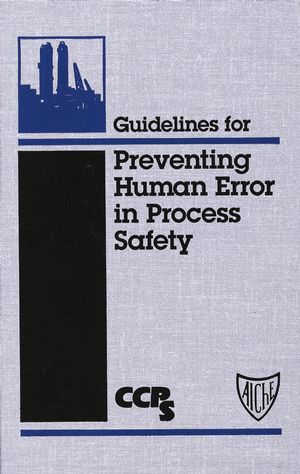Guidelines for Preventing Human Error in Process SafetyISBN: 978-0-8169-0461-7
Hardcover
416 pages
August 2004
 This is a Print-on-Demand title. It will be printed specifically to fill your order. Please allow an additional 10-15 days delivery time. The book is not returnable.
|
||||||
Preface.
Glossary and Acronyms.
1. Introduction: The Role of Human Error in Chemical Process Safety.
1.1 Introduction.
1.2 The Role of Human Error in System Accidents.
1.3 Why Is Human Error Neglected in the CPI?
1.4 Benefits of Improved Human Performance.
1.5 The Traditional and System-induced Error Approach.
1.6 A Demand-Resource Mismatch View of Error.
1.7 A Case Study Illustrating the System-Induced Error Approach.
1.8 From Theory to Practice.
1.9 Appendix Case Studies.
2. Understanding Human Performance and Error.
2.1 Purpose of the Chapter.
2.2 Concepts of Human Error.
2.3 An Overview of the Four Perspective on Human Error.
2.4 The Traditional Safety Engineering Approach to Accidents and Human Error.
2.5 The Human Factors Engineering and Ergonomics Approach (HF/E).
2.6 The Cognitive Engineering Perspective.
2.7 The Sociotechnical Perspective.
2.8 Summary.
2.9 Appendix 2A. Process Plant Example of the Stepladder Model.
2.10 Appendix 2B. Flowcharts for Using the Rasmussen Sequential Model for Incident Analysis (Petersen, 1985).
2.11 Appendix 2C. Case Study Illustrating the Use of the Sequential Model.
3. Factors Affecting Human Performance in the Chemical Industry.
3.1 Introduction.
3.2 Applications of Performance-Influencing Factors.
3.3 A Classification Structure for Performance-Influencing Factors.
3.4 Operating Environment.
3.5 Task Characteristics.
3.6 Operator Characteristics.
3.7 Organizational and Social Factors.
3.8 Interaction of Performance-Influencing Factors.
3.9 Variability of Human Performance during Normal and Emergency Situations.
3.10 Summary.
4. Analytical Methods for Predicting and Reducing Human Error.
4.1 Introduction.
4.2 Data Acquisition Techniques.
4.3 Task Analysis.
4.4 Human Error Analysis Techniques.
4.5 Ergonomics Checklists.
4.6 Summary.
5. Qualitative and Quantitative Prediction of Human Error in Risk Assessment.
5.1 Introduction.
5.2 The Role of Human Reliability in Risk Assessment.
5.3 System for Predictive Error Analysis and Reduction (SPEAR).
5.4 Critical Task Identification and Screening Analysis.
5.5 Qualitative Human Error Analysis.
5.6 Representation.
5.7 Quantification.
5.8 Summary.
5.9 Appendix 5A. Influence Diagram Calculations.
6. Data Collection and Incident Analysis Methods.
6.1 Introduction.
6.2 An Overview of Data Collection Systems.
6.3 Types of Data Collection Systems.
6.4 Organizational and Cultural Aspects of Data Collection.
6.5 Types of Data Collected.
6.6 Methods of Data Collection, Storage, and Retrieval.
6.7 Data Interpretation.
6.8 Root Cause Analysis Techniques.
6.9 Implementing and Monitoring the Effectiveness of Error Reduction Measures.
6.10 Setting Up a Data Collection System in a Chemical Plant.
6.11 Summary.
7. Case Studies.
7.1 Introduction.
7.2 Case Study 1: Incident Analysis of Hydrocarbon Leak from Pipe.
7.3 Case Study 2: Incident Investigation: Mischarging of Solvent in a Batch Plant.
7.4 Case Study 3: Design of Standard Operating Procedures for Task in Case Study 2.
7.5 Case Study 4: Design of Visual Display Units for Computer-Controlled Plant.
7.6 Case Study 5: Audit of Offshore Emergency Blowdown Operations.
8. Implementing an Integrated Error and Process Safety Management System at the Plant.
8.1 Introduction.
8.2 Managing Human Error by Design.
8.3 Setting Up an Error Management System in an Existing Plant.
8.4 Summary.
References.
Bibliography.
Index.



